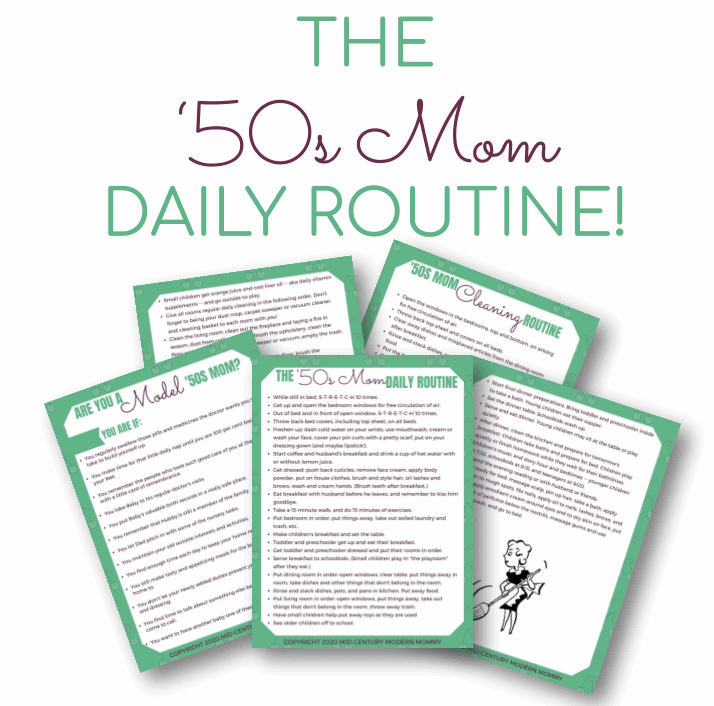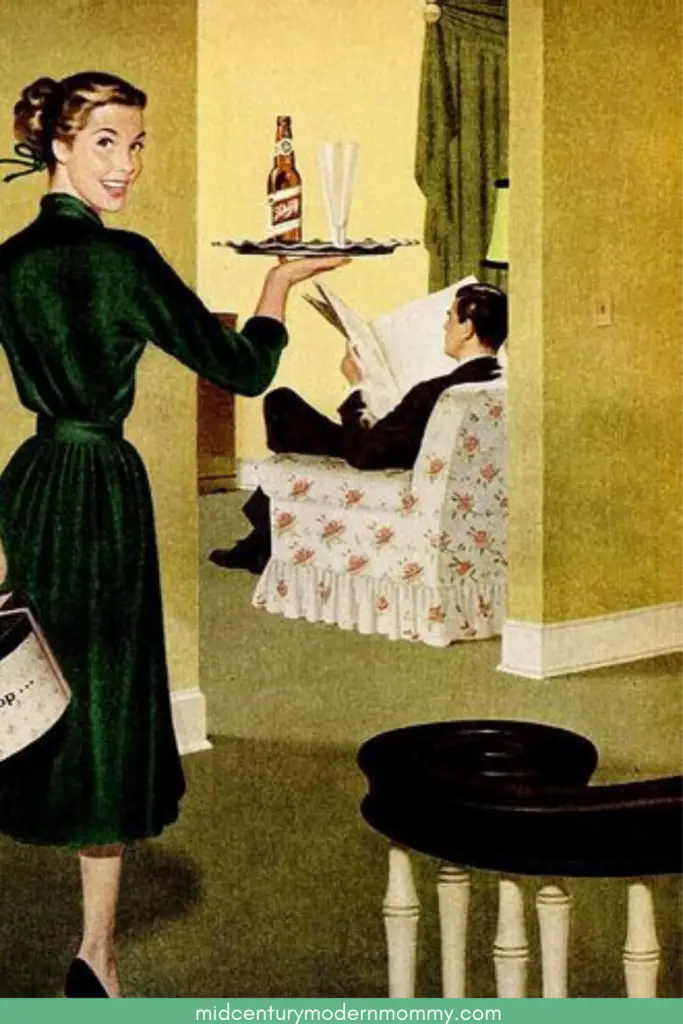Is there just one thing you can do to make your home clean, comfortable, and company-ready all the time?
I’ve been there. I’ve been the mom who talked to her sister on the porch because she was too ashamed to let her in. I’ve been the mom blearily washing out a milk cup at 5 in the morning so my thirsty kid can get a drink of water.
And there is 1 thing that is essential to a smoothly-run home, whether you are a vintage housewife living a 1950s aesthetic or a modern tradwife trying to learn the secret to running your home properly.

Get Our Mid-Century Mom Daily Routine FREE!
Orderliness is The Basis of a Well-Run Home
This post contains affiliate links. If you click a link and make a purchase, I may receive, at no additional cost to you, a small commission. Find out more on my Disclosures page, and thank you so much for your support!
The vintage emphasis on identifying an orderly home with respectability was rooted in the belief that a tidy environment promoted harmony and stability within the family unit.
An orderly home was seen as a sanctuary, providing a sense of comfort and security for both family members and visitors alike. Moreover, it was believed that a well-organized home facilitated efficient household management, allowing for smoother daily routines and less stress. This benefited everyone in the family.
The breadwinner husband benefited by having a legitimate outlet for “intimate” activities (this was seen as the foundational reason why men should marry since at least the Christian era of Western civilization) and support in building his career and his legacy.
The children, who were seen as part of that legacy, were benefited by having respectable behavior and social norms demonstrated that led them to do better in school and socially.
Having a well-ordered home was seen as essential to having a well-run society. And a well-run society created a bright future. A cohesive society with a common culture and moral philosophy gave everyone hope for the future, which led to great things for everyone.
Why You Need Order in Your Home
It takes much less time to establish order in a home than it does to look for things and clean up messes caused by disorganization.
It takes much less time and energy spent on housework to keep order and cleanliness in an organized home. And that leaves more time and energy for the little things that matter – date nights, self-care, dinner parties, and holiday baking with children, for example. When you create a home full of warmth, love, and respect, it is a place where real life happens beautifully.
By removing clutter and chaos, you remove an irritation that can sometimes cause a full-blown mental-health crisis (ask me how I know).
When you bring order to your life, your home, and your routines, you make daily life, for everyone, run a little bit more smoothly. It’s easier to have that clean and comfortable and cozy home you’re always imagining. It’s simple to invite a friend over, or host a get-together for your husband’s friends.
There is no right or wrong way to bring order to your home, but there are EASIER ways to do it, many of which have been lost due to generational feminism denigrating homemaking at the behest of corporations. Therefore, I have brought together the step-by-step how-tos and sound advice from my vintage home economists and their books to give you a method for bringing order to your life.

How to Create an Orderly Home
An orderly, organized life calls for creating and then sticking to clear-cut rules and guidelines, pre-set schedules, and to-do lists that are dictated by the lifestyle you and your family have, and the one that you envision.
Every home has its own requirements and circumstances and thus its own schedule. However, without an orderly plan and a schedule, good housekeeping is almost impossible. The basic steps to create a good plan are all essentially the same.
1. Get Yourself in Order
An orderly home starts with you, the homemaker.
Change Your Attitude
Any successful person knows that a change in thinking is the first step to victory.
Don’t punish yourself for past disorder. Instead, search yourself to see what is causing all that confusion. See if you can’t get rid of that internal clutter before you move on.
Once you’ve “let go” and forgiven yourself for past disorderly homemaking, it’s time to create some habits that will help you to get yourself in order.
Change Your Appearance
You are not in order when you are the dumpy, frumpy housewife.
Start by getting up 30 minutes before the rest of the family. (This doesn’t mean that if your husband gets up at 3:30, you have to get up at 3. But it does mean that you should be aiming to get 30 minutes by yourself before your children get up.)
Use that half hour to take a shower, fix your hair, put on makeup (if you wear makeup out, you should wear it at home), and dress. Incidentally, getting dressed means all the way down to SHOES. If you wear slippers, that tells your mind. “Oh, we’re going to lounge around today.”
Another thing to add here is quiet time. My quiet time in the morning, because I am Catholic and overly Academia, is a Morning Offering, the Angelus, and a cup of herbal tea while I read the Bible in Latin and journal. I usually squeeze this in during my 1950s morning beauty routine, just after I drink hot water with lemon, right there with my exercises.
If you are in a season with small babies, you might only be able to squeeze in 15 minutes. In that case, focus on 5 minutes of quiet, a cup of tea, and a simplified skin-hair-makeup-dressed routine that still helps you feel pretty. These super-stressful seasons are the times that we most need to feel good about ourselves.
Getting up early also helps to avoid the dreaded morning rush.
Change Your Habits
Habits are automatic actions that take no conscious thought.
When we walk, we don’t have to think about it; we just do it. Good habits are silent helpers. Organized people have established a force of good habits.
Work on establishing new habits. It takes 21 days to establish a habit, but it’s a good idea to give yourself some grace and plan 4 weeks to change a habit. Hopefully, after 3 weeks of picking things up instead of passing them up, your brain will hurt when you step over the coats on the floor.
Establish these habits:
- Put things where they belong when you are through with them.
- Set the standard for orderliness yourself.
- Never leave the room before closing closets, cupboard doors, and drawers.
- PICK IT UP, DON’T PASS IT UP!
- When you fix anything to eat, put away everything you used before you sit down to eat.
- Dress, hair, and makeup before ANYTHING.
- Never leave the house before you’ve done all your daily chores.
- Check the next day’s schedule and menus, and everything everyone will need to leave with in the morning (boots, coats, umbrellas, schoolbags, etc.), the night before.
- Finish what you start.
- Tidy your living room before going to bed at night.
- Leave the kitchen clean before going to bed at night.
Make Your Bed
Flylady told you to start with the kitchen sink, but I tell you to make your bed instead.
Why? Because your bed is your marriage bed, the symbol of your marriage. And as a vintage housewife, your marriage is the centerpiece of your existence – otherwise, you’d just be you, not a housewife.
If you are a housewife, you put your marriage first, then taking care of your husband and yourself which supports the marriage, then taking care of your home and your appearance which showcases your marriage, and finally, raising your children – together – which generational attitude is the fruit of your marriage.
So make having a beautiful, well-aired, properly-made marriage bed the centerpiece of your marriage bedroom as well as your housekeeping.

2. Organize Your Routines
The next step is to organize your routines.
Every household will need different routines, but every home also has the same basic underlying needs.
The key is to personalize the activities and then the routines for your own home.
Make An Activity List
An orderly vintage home begins with a list of potential homemaking activities.

First write down the jobs that need to be done every day. Next, write down the tasks that need to be done on a particular day of the week. Then make a simple chart, and write down each job at the day and hour when it is most convenient to work it in.
This list is a start towards making a reasonable plan, but it is not complete. You will need to identify what kind of tasks come under each of the headings in the list.
As you personalize your own Activity List you’ll include: what has to be done, how often it should be done, how long it will take, and whether you can delegate it to your husband, children, or outside help.
For example, what will constitute cleaning each room? You can see a complete list of each vintage cleaning task in my 1940s cleaning routine, which comes from this same book.
Or what comes under the heading of entertaining? Hosting dinner at home twice a month? Then you’ll need tasks like buying flowers, planning the menu, sending invitations, and hiring a babysitter or waitress for regular evenings.
One way to do this is to envision each room, and what you would like to have done to it to make it nice. Then do the same with your children’s grooming and self-care, and your own. Then add social activities.
For example, you probably want your children to follow a standard routine of putting away toys, taking a bath, putting on pajamas, washing hands and face, and brushing teeth and hair before bed every night. Write it down. Before-school routines, prayer routines – add all of it.
Just a note on the activities as you envision them: put down how often you want to do it, NOT HOW OFTEN YOU’RE DOING IT NOW. The idea is to plan to do a job often enough so the house is as clean as if you had a cleaning lady come in.
Make a Housework Schedule
Experienced housewives may carry their schedule in their heads. As a beginner, you will want to get yours on paper, where you can study it, change it, and finally perfect it.
So, once you have your activity list, you can plug in your housekeeping tasks into a time-block schedule plan like this:

If you want to make sure you have time for sewing, you’d probably add that in the late afternoon. Early evenings might include family time, a family rosary, or overseeing homework and bedtime routines. Early morning would include your morning routine and dressing time before preparing breakfast.
Start your scheduling with mealtimes. Because mealtimes are more or less fixed by custom or necessity, and because they are the most important part of the family’s day, it is easiest to start your scheduling with these. Really the whole schedule should revolve around:
- Your husband’s work and leisure schedule
- Family meals
- Care of babies
- Self-care
- Care of older children
The importance of keeping this a time block schedule is so that you can include your children’s schedules, even when they are babies. Older children, especially with good discipline, need less of your hands-on attention. But family meals should be the priority for beginning the whole family together.
If there is a small baby, the whole household schedule must be built around the schedule for the husband, the baby and mealtimes, and more often than not there is very little time left for housework, particularly if household help is not employed. A recent study showed that the care of a new baby takes 5 hours and 41 minutes of active care every day, and the next priority will need to be the mother taking care of herself.
If you look at my vintage baby schedules, you will see times for specific tasks and long blocks of time open between those tasks. Those spaces of time are where you can jump in with the housekeeping tasks in the time block schedule.
Young children, children of school age, an invalid or elderly person to be cared for all necessitate special adjustments in work schedules. Basically, the time block schedule allows you to put baby or invalid care first, and then the most important housekeeping (meal prep, hygiene) can be put in. Anything else can be gotten to when there is time, or left (if there isn’t time) until the next time that exact block rolls around while you go on to the next block.
Plan Out the Routines
So now, the next step is to get your routines in order.
The goal here is to create routines that are set up with enough time, and in the best order.
Start your routines with mealtimes. Because mealtimes are more or less fixed by custom or necessity, it is easiest to start your scheduling with these. You know that you’ll need a certain amount of preparation and clean up time, and that you’ll want to try to have these at a fixed time for the sake of your kids and husband.
The time you choose for dinner will depend a great deal on your husband.
Five minutes after your husband comes in the front door at night may be the time he wants his dinner; or he may prefer to shower and change first. Your schedule will reflect this.
Since dinner is the high spot of your housekeeping day, allow plenty of time for its preparation. This will enable you to have extra time for taking a tub or shower yourself and generally making yourself lovely for dinner.
For a six o’clock dinner, add these fill-ins to your schedule:
- 4:00 to 6:00 Dinner preparation. (This may be twice as long as necessary, but allow it anyway to start with – especially if you are just learning to cook, or you are feeding the children their nursery supper while you cook.)
- 6:00 to 7:00 Dinner.
- 7:00 to 7:30 Dishes and kitchen cleanup.
Next, you want to cast your housework routines in as efficient a manner as possible.
This is an ideal. How nearly you can approach this ideal, especially as to daily cleaning, is up to you. But a listing of jobs to be done in each room, in their proper order, will prove a helpful guide.
Finally, you will want to plan out your morning and evening beauty routines, and your children’s grooming routines.
My children’s routines are based on this:

It’s from 1946, and is meant for high school girls, but it is easily adapted to all ages of children. I also have a routine for teaching this to my 1 year olds. Below that age, I simply do this for them myself.
Ease Into a Schedule
Once you have the best order for all your routines, you can start moving into a schedule. This is where that habit of getting all your “dailies” done before you leave the house comes in handy.
In short, your dailies in a clean, company-ready home are:
- Make the beds and put away the pajamas
- Wash dishes and wipe counters after every meal
- Wipe down the bathroom after every use
- Tidy the living areas – get rid of trash, put away books and toys, etc.
- Sweep or vacuum all the floors
- Take out the garbage and reline the pail
Those things are the bare minimum, although a modern housewife has to add laundry as well. (A vintage housewife had a very different way of doing laundry, that made it a weekly chore.)
Your personal dailies are:
- Daily bath, shower, or sponge bath and a deodorant
- Hair and makeup every day
- Clean underthings once or twice a day
- Exercises
- A rest
- Change for dinner
- Care for your clothes
And of course, there are also some things that you will want to do for your marriage every day as well:
- Dinner at a set time
- Breakfast at a set time (Add lunch, if he comes home for lunch)
- Spend some of your free time doing 2 things that make you feel happy, and 1 that makes you feel healthy/good
- Prepare the house for his return home
The last one may need a bit of explanation, because it goes beyond the first things a vintage housewife should do for her husband. Basically, you can use this list to prepare the house for his arrival, especially if he has a difficult job:

No one is quite sure if this is ACTUALLY from a 1950s home ec textbook, but it remains an excellent way to make some feel welcomed home. In particular, minimizing noise can help hugely . (I am known to save screen time for this purpose.)
Also, the habit of sitting with your husband on the couch for 15 minutes after he gets home, listening to him talk, and preferably with a cocktail or mocktail of your devising, is an amazing habit to get into. Not only is it a really good way of making your husband feel loved, but it is also a really good signal to your kids that your marriage is important.
However, some men need that 15 minutes alone and quiet more than they need to talk. If that’s your husband, greet him at the door with a kiss looking pretty, and be grateful for the extra 15 minutes to get the couch and drinks tray ready! Let him have 15 minutes of alone and quiet time to get changed, settle in, and have his quiet time before you sit down and listen to him for 15 minutes.
But fitting all these things into a schedule is actually hard to understand. The best way to start easing into a schedule is either by task or by time.
To start a schedule by task, you would take one of the categories above, with clean home, marriage, or appearance, and turn those tasks into habits. Basically, you plan each of the tasks in the list to occur following the cue, craving, response system, by setting those particular tasks to occur at specific times or after already established habits. You can then stack the tasks from another list, and another.
The other approach to a schedule is to start by choosing a time to implement the schedule – say, the morning – first. Only hold yourself to the schedule until lunchtime for a week or so. Then add more and more time. I talk about this approach as the stay-at-home mom schedule.
Either way, your goal is to be able to do your housekeeping, self-care, childcare, mealtime and marriage routines on a daily and weekly basis without having to think about what comes next. (This will relieve a big source of chronic stress by reducing the burden on your working memory.)

3. Organize Your Home
And the biggest thing here is CURATE.
This is a whole ‘nother article, but here are some basic vintage organizing tips:
A Place for Everything
Don’t have anything in your home that doesn’t have a loving place. That might mean decluttering things that aren’t used or loved. But do make sure that everything in your home is something that you are grateful enough to have that you are willing to do the work to find it a good place.
And Everything in Its Place
This goes back to the tidying habits of not stepping over things and closing doors and drawers, etc. Putting things back in their place constantly is a habit that sets a good example for your children and teaches them eventually to do the same.
Make It Cozy
This is going to depend a lot on your personality, your family, and what your husband wants.
He may love one type of decorating and you love something different. Often, in that case, you’ll “compromise” and one of you will get your style! But there are a lot of things that make husbands feel uncomfortable in their own homes, such as spindly furnishings, frou-frou and ruffles everywhere, too many tchotchkes, or things constantly being tidied and cleaned around them.
Avoid making your husband feel unwelcome in your home. It will be much easier to make your own comfort in little ways if you spend a lot of time at home, while primarily accommodating his style.
Make It Orderly
Another thing you should aim for as a vintage housewife or a tradwife is to create a home that is orderly enough that you can find things, which is easy because you are home all the time, and your husband and children can find things without asking, which is MUCH harder.
This is another of those stresses and working memory overloads that good housekeeping can alleviate. Part of it is about having a place for everything, and the rest of it is about storage.
Your home essentially needs two kinds of storage: working storage, which is a food pantry, your linen closet, and suchlike, and a storage area which is to clear the main part of the house from seasonal and seldom-used items.
ALL of your storage should have labels. Labels help you take the information out of your working memory to free up energy and space for important things like fun family time.

4. Organize Your Life
This is actually the fun part. This is when you get to start thinking about celebrations, holidays, monthly family fun, and seasonal activities.
Family culture is an important part of a smoothly-run home. It means you need to know in advance what’s coming up and how to prepare. Things like registering for summer camp in March, or sending a birthday card in advance help family life run smoothly and with less for you to remember.
This will all be dependent on your own family, but it helps to have a month-by-month calendar and write the seasonal activities, one a day, to add to each day’s to-do list and routines. I usually try to do these things along with the weekly chores that I do each day. You can see what this looks like in my week-by-week homemaking checklists.
And that’s how you create a smoothly-run vintage home whether you’re a vintage housewife or a full-on tradwife.


Get Our Mid-Century Mom Daily Routine FREE!



